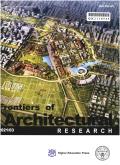Neighbourhood identity versus city identity: An inter-scalar perspective via urban layers in a historical zone under transformation
IF 3.6
1区 艺术学
0 ARCHITECTURE
引用次数: 0
Abstract
Post-socialist urban development in the Albanian capital, Tirana, is characterized by unplanned urbanization that led to the loss of the city's historical fabric. This study focuses on a historic neighbourhood of Tirana affected by urban transformation. It defines housing as the predominant function that has influenced the morphology of the neighbourhood and divides it into three layers, namely pre-socialist, socialist, and post-socialist.
The aim is to reveal the influence of each urban layer on neighbourhood and city identity. To achieve this goal, we rely on the concept of place identity, which consists of physical elements and identificatory relations. The methodology includes sampling of citizens (67 per layer), surveying (No = 201), GIS-mapping and data analysis by clustering physical elements (landmark, house, street, public space) and identificatory relation features (memories, experiences, social and self-identity aspects).
The results show that the city identity is reported to be slightly higher compared to the neighbourhood identity. The residents of older layers compared with those of newer have higher identification with both neighbourhood and city. Finally, the neighbourhood identity is generated by houses, as physical aspects, and socialization as identificatory relation, whereas city identity is generated by public spaces, as physical aspects, and as identificatory relation aspects socialization, and self-identity aspects.
邻里认同与城市认同:在转型的历史区域中,通过城市层的跨标量视角
阿尔巴尼亚首都地拉那的后社会主义城市发展的特点是无计划的城市化,导致城市历史结构的丧失。本研究聚焦于地拉那一个受城市转型影响的历史街区。它将住房定义为影响社区形态的主要功能,并将其分为三个层次,即前社会主义、社会主义和后社会主义。目的是揭示每个城市层对社区和城市身份的影响。为了实现这一目标,我们依赖于地点身份的概念,它由物理元素和身份关系组成。该方法包括对公民进行抽样(每层67人),调查(No = 201),通过聚集物理元素(地标、房屋、街道、公共空间)和身份关系特征(记忆、经历、社会和自我认同方面)进行gis制图和数据分析。结果表明,与社区认同相比,城市认同略高。老城区居民对社区和城市的认同感高于新城区居民。最后,邻里身份是由房屋产生的,作为物理方面,作为身份关系的社会化,而城市身份是由公共空间产生的,作为物理方面,作为身份关系方面,社会化和自我认同方面。
本文章由计算机程序翻译,如有差异,请以英文原文为准。
求助全文
约1分钟内获得全文
求助全文
来源期刊

Frontiers of Architectural Research
ARCHITECTURE-
CiteScore
6.20
自引率
2.90%
发文量
430
审稿时长
30 weeks
期刊介绍:
Frontiers of Architectural Research is an international journal that publishes original research papers, review articles, and case studies to promote rapid communication and exchange among scholars, architects, and engineers. This journal introduces and reviews significant and pioneering achievements in the field of architecture research. Subject areas include the primary branches of architecture, such as architectural design and theory, architectural science and technology, urban planning, landscaping architecture, existing building renovation, and architectural heritage conservation. The journal encourages studies based on a rigorous scientific approach and state-of-the-art technology. All published papers reflect original research works and basic theories, models, computing, and design in architecture. High-quality papers addressing the social aspects of architecture are also welcome. This journal is strictly peer-reviewed and accepts only original manuscripts submitted in English.
 求助内容:
求助内容: 应助结果提醒方式:
应助结果提醒方式:


